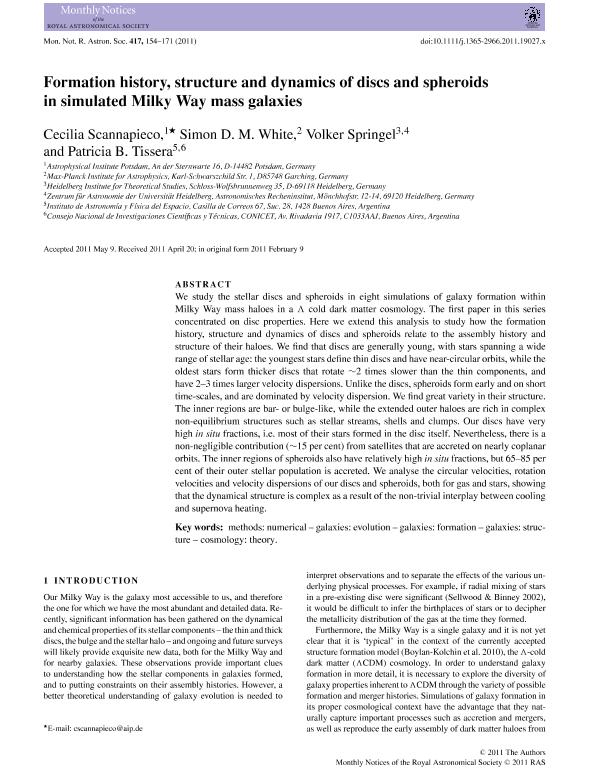Mostrar el registro sencillo del ítem
dc.contributor.author
Scannapieco, Cecilia

dc.contributor.author
White, Simon D. M.
dc.contributor.author
Springel, Volker
dc.contributor.author
Tissera, Patricia Beatriz

dc.date.available
2017-07-10T20:03:41Z
dc.date.issued
2011-10
dc.identifier.citation
Scannapieco, Cecilia; White, Simon D. M.; Springel, Volker; Tissera, Patricia Beatriz; Formation history, structure and dynamics of discs and spheroids in simulated Milky Way mass galaxies; Oxford University Press; Monthly Notices of the Royal Astronomical Society; 417; 1; 10-2011; 154-171
dc.identifier.issn
0035-8711
dc.identifier.uri
http://hdl.handle.net/11336/20033
dc.description.abstract
We study the stellar discs and spheroids in eight simulations of galaxy formation within Milky Way mass haloes in a cold dark matter cosmology. The first paper in this series concentrated on disc properties. Here we extend this analysis to study how the formation history, structure and dynamics of discs and spheroids relate to the assembly history and structure of their haloes. We find that discs are generally young, with stars spanning a wide range of stellar age: the youngest stars define thin discs and have near-circular orbits, while the oldest stars form thicker discs that rotate ∼2 times slower than the thin components, and have 2–3 times larger velocity dispersions. Unlike the discs, spheroids form early and on short
time-scales, and are dominated by velocity dispersion. We find great variety in their structure. The inner regions are bar- or bulge-like, while the extended outer haloes are rich in complex non-equilibrium structures such as stellar streams, shells and clumps. Our discs have very high in situ fractions, i.e. most of their stars formed in the disc itself. Nevertheless, there is a non-negligible contribution (∼15 per cent) from satellites that are accreted on nearly coplanar orbits. The inner regions of spheroids also have relatively high in situ fractions, but 65–85 per cent of their outer stellar population is accreted. We analyse the circular velocities, rotation
velocities and velocity dispersions of our discs and spheroids, both for gas and stars, showing that the dynamical structure is complex as a result of the non-trivial interplay between cooling and supernova heating.
dc.format
application/pdf
dc.language.iso
eng
dc.publisher
Oxford University Press

dc.rights
info:eu-repo/semantics/openAccess
dc.rights.uri
https://creativecommons.org/licenses/by-nc-sa/2.5/ar/
dc.subject
Methods:Numerical
dc.subject
Galaxies:Evolution
dc.subject
Galaxies:Formation
dc.subject
Galaxies:Structure
dc.subject
Cosmology:Theory
dc.subject.classification
Astronomía

dc.subject.classification
Ciencias Físicas

dc.subject.classification
CIENCIAS NATURALES Y EXACTAS

dc.title
Formation history, structure and dynamics of discs and spheroids in simulated Milky Way mass galaxies
dc.type
info:eu-repo/semantics/article
dc.type
info:ar-repo/semantics/artículo
dc.type
info:eu-repo/semantics/publishedVersion
dc.date.updated
2017-07-10T13:26:21Z
dc.journal.volume
417
dc.journal.number
1
dc.journal.pagination
154-171
dc.journal.pais
Reino Unido

dc.journal.ciudad
Londres
dc.description.fil
Fil: Scannapieco, Cecilia. Leibniz Institut Fur Astrophysik Potsdam; Alemania. Consejo Nacional de Investigaciónes Científicas y Técnicas. Oficina de Coordinación Administrativa Ciudad Universitaria. Instituto de Astronomía y Física del Espacio. - Universidad de Buenos Aires. Facultad de Ciencias Exactas y Naturales. Instituto de Astronomía y Física del Espacio; Argentina
dc.description.fil
Fil: White, Simon D. M.. Gobierno de la Republica Federal de Alemania. Max Planck Institut Fur Astrophysik; Alemania
dc.description.fil
Fil: Springel, Volker. Gobierno de la Republica Federal de Alemania. Max Planck Institut Fur Astrophysik; Alemania
dc.description.fil
Fil: Tissera, Patricia Beatriz. Consejo Nacional de Investigaciónes Científicas y Técnicas. Oficina de Coordinación Administrativa Ciudad Universitaria. Instituto de Astronomía y Física del Espacio. - Universidad de Buenos Aires. Facultad de Ciencias Exactas y Naturales. Instituto de Astronomía y Física del Espacio; Argentina
dc.journal.title
Monthly Notices of the Royal Astronomical Society

dc.relation.alternativeid
info:eu-repo/semantics/altIdentifier/url/http://mnras.oxfordjournals.org/content/417/1/154
dc.relation.alternativeid
info:eu-repo/semantics/altIdentifier/doi/http://dx.doi.org/10.1111/j.1365-2966.2011.19027.x
Archivos asociados
